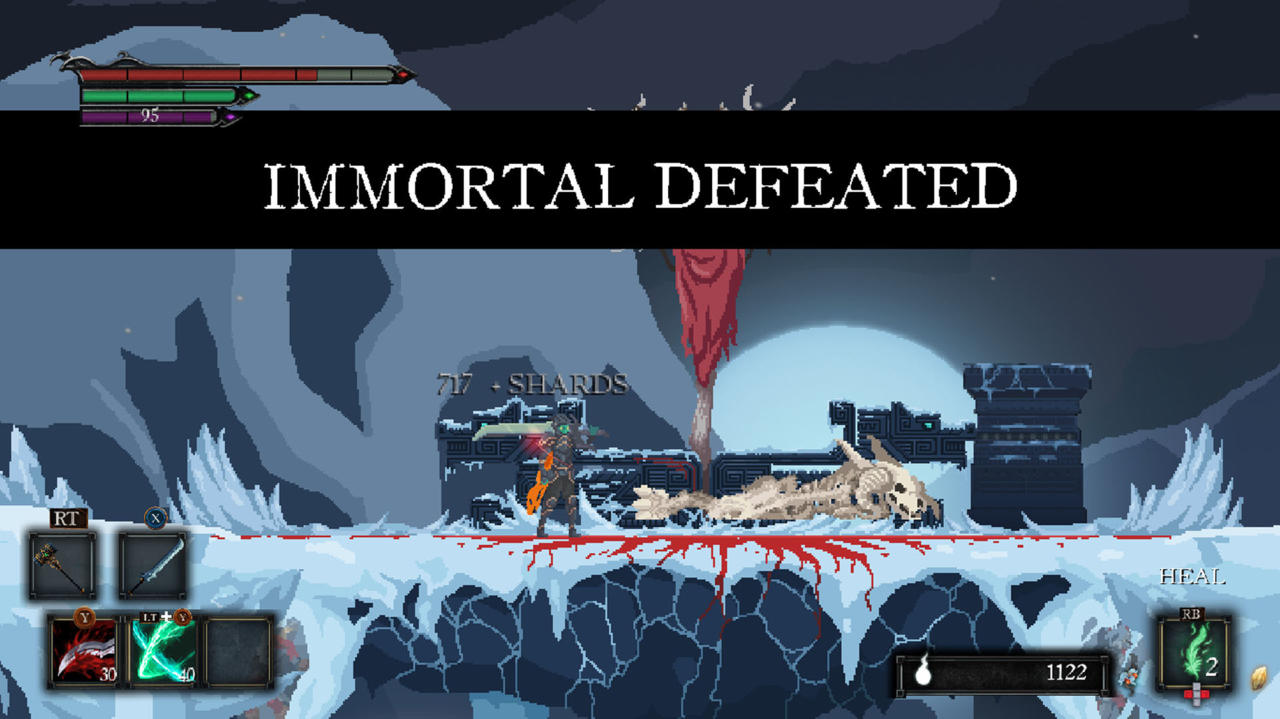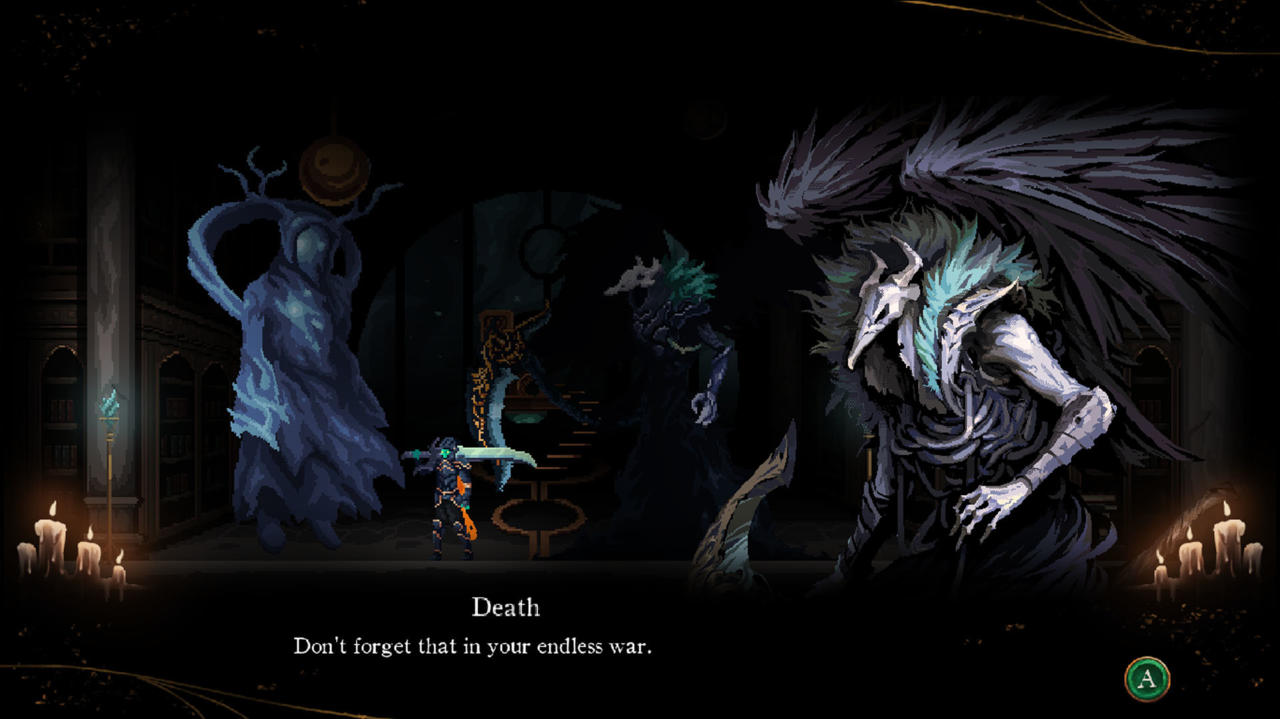With its interconnected world, gorgeous character design, and strong story premise, Death's Gambit looks every bit the promising 2D action-platformer on paper. Although inconsistent combat and sluggish movement combine to rein in that promise, some clever gameplay tricks and distinctive boss fights keep things refreshing enough to lessen the grind.
Death's Gambit shrouds itself in mystery from the get-go, giving you very little information before setting you off into its gorgeous pixel-art labyrinth. You select a class and an item to start with, a choice that proves largely inconsequential except for your starting skill points, before waking up on a burning battlefield. You control Sorun, a soldier who is granted immortality after signing a contract with Death to wipe the land of other immortal beings. It's a great premise that's backed up by some strong story sequences that play out between your inevitable deaths, helping to set up Sorun's tragic background and the beginning of his journey as one of Death's personal handlers.
The core gameplay loop will feel very familiar to anyone who's spent some time with From Software's Souls games. Progress comes through grinding it out against powerful enemies, death after death, and combat requires exact timing of both attacks and defensive maneuvers. As you venture deeper into the world, the basics are taught through inscribed gravestones that rise from the ground as you pass near them. As you slice and hammer your way through enemies, you'll collect shards that are used to level up character skills. You spend these points at Death Idols, statues scattered around the world where you can rest to level up and respawn after death.

Death's Gambit diverges from the established formula when you die, because you don't drop your collection of shards. Instead, you drop a Phoenix Plume, a feather that's used predominantly to heal yourself but can also be imbued into your weapon to increase its attack damage. And although you can collect them from where you died, you can also spend shards to reclaim lost Plumes--handy given that the world is one big linked maze and its easy to lose track of plumes. Given Plumes aren’t tied to player progression, it can encourage you to take a more gung-ho attitude when entering fights, which rarely go in your favor at first.
With the exception of the largest variants, enemies will respawn every time you rest at an Idol, giving you plenty of opportunities to grind out shards and gain early levels quickly. But despite this, there are numerous areas where the difficulty spikes harshly and progress screeches to a halt. More often than not this also means replaying the same sections over and over, highlighting some of the more irritating and inconsistent parts of the game's combat, which oscillates from calculated and tactical to slow and cumbersome with annoying regularity.
Combat feels deliberately heavy. Attacks are beautifully animated and need a short wind up before the strike, placing an emphasis on timing over button-mashing. Landing hits in combat fills your soul meter, which is used to trigger weapon abilities, and these can range from powerful attacks to defensive spells. But while there are occasional moments when it feels like it comes together, all too often it feels unsatisfying in the end. This partly comes down to movement feeling awkward, both when in combat and while platforming in general, but also because it relies excessively on stamina management, requiring a level of patience the combat rarely earns. Jumps feel underpowered and imprecise, and the weapons themselves, aside from a bit of visual flair, feel plain and unexciting to use. Encounters just feel flat, and when you mix that up with enemies that can kill you with ease, it doesn't make for a great time.

Thankfully, the world isn’t just full of enemies; there are some friendly characters you’ll meet along the way too. Most folks you meet will wind up back in the game’s main hub and safe area, Central Sanctuary. The shopkeeper there will sell you items and auras, while many others will teach you new weapon abilities, provided you have the shards to pay for them. The cast of characters you'll meet along the way are all gorgeously designed, especially their avatars shown during dialogue sequences. Death and Origa are particular highlights; with Death's broad, imposing wings and intricate vest, and Origa's battle-worn armor and hooded cloak.
Bosses are visually less consistent, ranging from an imposing but detailed Gaian giant the size of an apartment building to the Tundra Lord, who looks like a horned zombie beast that was half chewed and spat out; noticeably lacking the detail present on other characters. Boss fights also offer the most interesting departure from the typical moment-to-moment activities, with some delightfully mind-bending sequences where the world warps and twists; the Thalamus fight is a particular highlight, relying less on combat and more on reactions and memory. It's very clever.
Despite its rewarding exploration and intriguing story, Death's Gambit is consistently held back by its combat, which lacks the responsiveness you need when fighting enemies that can kill you in seconds.
Most impressive, though, is the environmental art and world design. Its weaving, interconnected layout can cause you to get lost at times, but it's small enough that moving from place to place doesn't take long if you’ve cleared it of enemies. The world will change over time, too, either after taking down certain bosses or after you’ve found a particular item, granting access to previously blocked off regions. Exploration feels rewarding as there’s no shortage of things to uncover, like tomes that grant a small damage bonuses against certain bosses, or a link back to another part of the world, opening up new shortcuts and streamlining the world traversal in a way that’s appreciated after hours and hours of grinding the same locations.
Despite its rewarding exploration and intriguing story, Death's Gambit is consistently held back by its combat, which lacks the responsiveness you need when fighting enemies that can kill you in seconds. Occasionally it feels like it all comes together, but too often it's a chore, and when you're into your 30th run of the same section of a dungeon and you get piled on, it's crushing. While I was turned off by the excessive grind, Death's Gambit offers some pay off to those who don't mind pushing through the gauntlet. But you'll really have to work for it.



















